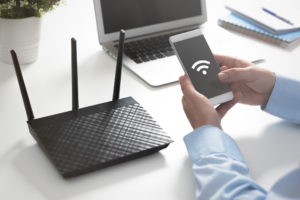
This new technology isn’t too widespread yet, but vendors like Cisco already offer routers compatible with the new standard, and other brands and devices will soon follow in their footsteps, according to the CNET article “Wi-Fi 6: Better, faster internet is coming – here’s what you need to know.”
If you’re wondering what exactly Wi-Fi 6 is and how it might affect your organization, here are the answers to a few key questions about the new standard.
1. What is Wi-Fi 6? It’s the latest 802.11 standard for wireless network transmissions, according to CNET. In other words, it’s the next generation of Wi-Fi technology. It’s backwards-compatible over 802.11ac, a.k.a. Wi-Fi 5.
2. What’s different about this newest version of Wi-Fi? This new technology promises various benefits, compared to Wi-Fi 5. Here’s an overview of the main advantages to expect from Wi-Fi 6, according to Cisco and the Wi-Fi Alliance.
- Greater speed. You can expect speeds of up to 4 times faster than earlier Wi-Fi standards could achieve. That means applications that use a lot of bandwidth (e.g., voice and video apps) will perform better.
- More battery life. Thanks to Target Wake Time (TWT), Wi-Fi 6 allows for increased battery life for Wi-Fi devices.
- Improved network capacity. Transmit beamforming allows for greater data rates.
- Less frequency interference. Oversaturated frequencies can create difficulties for businesses sharing buildings, but Wi-Fi 6 can help with that.
- More throughput. In certain emerging use cases that involve high bandwidth usage, Wi-Fi 6 can allow for greater throughput because of 1024 quadrature amplitude modulation mode (1024-QAM).
- Better performance in places with a lot of connected devices. Due to a feature called multi-user multiple input, multiple output (MU-MIMO), you can transfer more data at once with Wi-Fi 6. That means the technology is better at supporting numerous devices at the same time.
- More efficiency and less latency in demanding settings. The new technology achieves this through uplink and downlink orthogonal frequency division multiple access (OFDMA).
3. Is Wi-Fi 6 related to 5G? Although they are both becoming widespread at the same time, 5G – the fifth generation of cellular networking technology – is its own distinct technology. Both offer more speed, less latency and greater capacity. However, Wi-Fi 6 is a wireless local area network (WLAN) standard meant for homes, offices and crowded public spaces, while 5G is a wide area network (WAN) solution intended for cellular data and non-interior connectivity, according to the TechRepublic article “Wi-Fi 6 (802.11ax): A cheat sheet.”
4. How can my business benefit from Wi-Fi 6? To take full advantage of the increased speed, capacity and more offered by Wi-Fi 6, you’ll need compatible devices and infrastructure. You’ll want to consider whether your existing wireless access points (WAPs) and data switching infrastructure can handle the update. Our team of expert techs can assist you.
Here are some other pre-requisites for Wi-Fi 6 that all businesses should keep in mind.
- Ensure going forward your infrastructure wiring for WAPS is CAT6+ to handle higher speeds.
- Make sure your core switching equipment is 10G Ethernet. Standard networking equipment does not currently support 10G PoE (Power over Ethernet) in a cost-effective way. As a result, having one switch support 10G PoE is important.
- Ensure your core firewall can support 10G. Switch to firewall should be 10G+. Whether that’s through fiber or ethernet is up to you. More firewall solutions are providing more affordable 10G ethernet ports.
- Standard workstations and desktops don’t provide 10/100/1000/10,000 (a.k.a. 10G) ports. However, you can add those. When you are planning, be sure to take a full glimpse of your network.
- True end-to-end higher speed networks follow this.
If you have any questions about Wi-Fi 6, don’t hesitate to reach out to our team of IT experts. We have experience working with a wide range of IT solutions and can assist you in finding products and services that match your organization’s specific needs. Contact us today by calling 877-599-3999 or emailing sales@stratospherenetworks.com.


